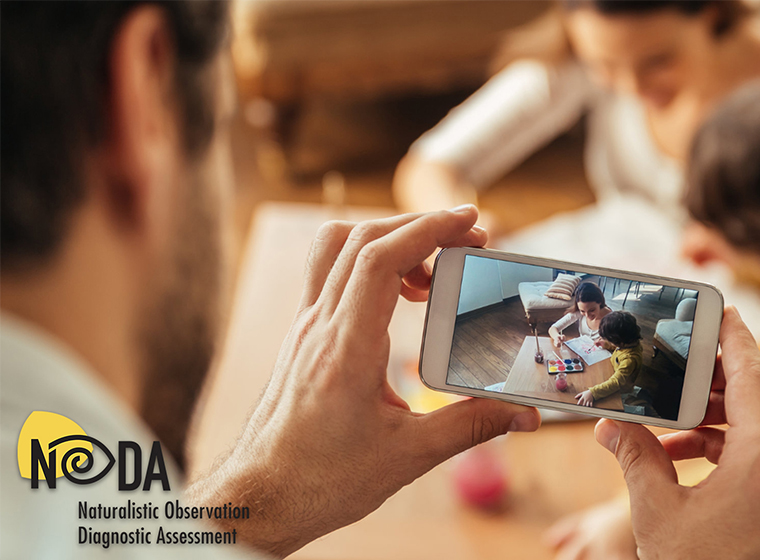There’s no blood test or MRI or CT scan. No single telltale biomarker. No biopsy. The process of diagnosing autism spectrum disorder (ASD) is more complex than that, requiring observation, interviews and testing to round out an assessment. These procedures can take a great deal of time for families once in the diagnostic center.
And too much time in the doctor’s office with small children is never much fun … for anyone. But at SARRC, families can save time and perhaps eliminate some discomfort for their kids, thanks to NODA™. NODA — the Naturalistic Observation Diagnostic Assessment (NODA) — is a smartphone-based system that lets parents record and send videos to SARRC for analysis in advance of an on-site evaluation and significantly shorten the length of time they are in the office.
NODA At Work
At her daughter Ella’s 24-month well visit in September, Stephanie Berube’s pediatrician expressed concern about development. Ella had already been seeing a speech therapist after concerns at her 18-month appointment.
“She suggested we go to SARRC,” Berube says. “We contacted them and started the paperwork. Then, they had us use NODA. They said it would be a better experience for Ella, because kids are often better at home than in a new environment with new people.”
NODA, which SARRC developed with the Georgia Institute of Technology and Behavior Imaging Solutions, was designed to help families who lived far away get a diagnosis without extensive travel. But after nearly four years in use, NODA’s success and benefits have been applied to more families; it’s now a standard part of the diagnostic process at SARRC for children 6 years of age and younger.
“We’re using NODA to shorten the in-person assessment time — not replace it,” says Christopher J. Smith, Ph.D., vice president and research director at SARRC. NODA can diagnose ASD (or rule it out) for most children, but an in-person assessment is still required. That’s because in order to demonstrate a child needs services, quantifiable evidence of a delay
in socialization or communication must be included.
“NODA only documents the presence of symptoms, but doesn’t provide quantifiable measurements of delays,” Dr. Smith says. “You need another kind of assessment to do that, so we need to meet with the family in our office.”
Using NODA in advance of the appointment shortens a family’s time at SARRC from about five hours to two.
“So, the in-person appointment is much shorter, and psychologists have access to very rich information on the child, seeing things they may not have seen during the office appointment, before the family even comes in,” he adds.
How NODA Works
Parents download the app and set up a secure account. Then, the NODA app prompts them to record and upload short videos of their child in various situations at home — mealtime, bedtime, playtime with others, and playtime alone. Clinicians at SARRC then view the videos, tag behaviors relevant to a diagnosis of autism and NODA organizes these tags according to DSM-5, prepared for review by a psychologist.
Berube recalls starting the process after her daughter’s appointment in September, completing paperwork, submitting videos and going into SARRC about two weeks later. They had Ella’s diagnosis of ASD by November. The time from the pediatrician screening to diagnosis can take 6 months or more.
That’s a long time to wait for answers when you are concerned about your child’s development and would like access to early intervention therapies. For Berube, that diagnosis is important because it means Ella can have access to covered services.
“We’re meeting with the school district and going through that stage right now,” Berube says. “The diagnosis helped me get her into a preschool program.”
The Future Of NODA
One recent development that benefits NODA and SARRC’s families, Dr. Smith points out, is that AHCCCS (Medicaid) updated its guidelines to include “store and forward” telehealth technology. Previously, only real-time video was acceptable, which would be a lot less convenient for parents and providers alike because it requires both parties to be available at the
same time. Scheduling that kind of meeting can slow things down significantly. With store and forward (the technology NODA relies on), families can record videos
on their own schedule, and SARRC staff can review videos whenever they have time.
“That was a huge milestone to meet toward wider acceptance of NODA,” Dr. Smith says. “Now more providers can begin to use NODA. Hopefully, commercial insurers will follow suit.”
Beyond clinical application, the app is used in research around the globe. SARRC just finished a project with monolingual Spanish speaking families, so the app was translated into Spanish. It has also been translated into Japanese and Swedish, and it is now being used in an epidemiological study in Saudi Arabia, establishing their national rates of autism.
Undoubtedly, there’s a tremendous amount of exciting work ahead, but for Dr. Smith, the real excitement is for parents like Stephanie Berube.
“Families report positive experiences with NODA,” he says. “They’re saying it’s easy to use and it really captures important behavior. As a result, they get answers sooner, and that’s a good thing.”
Research Shows Smartphone-Based Assessment Expedites Autism Diagnosis
Research studies show that families received a diagnosis 50% faster with NODA than those who did a traditional in-person assessment. Learn more »
Article by Stephanie Conner

